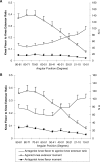Quantification of functional knee flexor to extensor moment ratio using isokinetics and electromyography
- PMID: 18174936
- PMCID: PMC2140073
Quantification of functional knee flexor to extensor moment ratio using isokinetics and electromyography
Abstract
Context: Evaluating moment balance around the knee helps athletic trainers set appropriate targets for injury prevention and rehabilitation programs.
Objective: To examine the knee flexor (KF) to knee extensor (KE) moment ratios using the moments when each muscle group acts as an agonist and using the moments when the KE acts as an agonist and the KF acts as an antagonist.
Design: Cross-sectional.
Setting: University research laboratory.
Patients or other participants: Seventeen pubertal males (age = 13.7 +/- 0.2 years, height = 1.61 +/- 0.04 m, mass = 51.3 +/- 2.7 kg).
Intervention(s): The subjects performed maximal isokinetic concentric KE (KE(CON)) and eccentric KF (KF(ECC)) efforts and performed eccentric KE (KE(ECC)) and concentric KF efforts at 60 degrees /s and 180 degrees /s while we recorded the bipolar surface electromyographic (EMG) signal of the involved muscles. The KF antagonist moment was estimated from EMG-moment relationships determined during calibration KF efforts. Maximal moments were used to estimate the KF:KE ratios, and EMG-based moments were used to estimate the antagonist to agonist ratios.
Main outcome measure(s): We calculated KF:KE ratios for various angular positions, velocities, and movement directions.
Results: The KF(ECC):KE(CON) ratio significantly increased as the knee extended (P < .05) at increased angular velocity (P < .05), reaching a value of 3.14 +/- 1.95 at full extension. The estimated knee flexor antagonist to knee extensor agonist ratio also increased near full extension (0.32 +/- 0.21).
Conclusions: Although the KFs have a higher capacity to produce maximal moment near knee extension and at increased angular velocities, knee joint movement is achieved through a balanced coactivation of the 2 antagonistic muscle groups to maintain joint stability and movement efficiency. The combined use of moment and EMG data can provide additional useful information regarding muscle balance around the knee.
Keywords: coactivation; injury index; muscle balance; rehabilitation; strength.
Figures





Similar articles
-
Functional eccentric-concentric ratio of knee extensors and flexors in pre-pubertal children, teenagers and adult males and females.Int J Sports Med. 2007 Sep;28(9):768-72. doi: 10.1055/s-2007-964985. Epub 2007 May 11. Int J Sports Med. 2007. PMID: 17497581
-
Antagonist muscle coactivation during isokinetic knee extension.Scand J Med Sci Sports. 2000 Apr;10(2):58-67. doi: 10.1034/j.1600-0838.2000.010002058.x. Scand J Med Sci Sports. 2000. PMID: 10755275
-
Antagonist moment of force during maximal knee extension in pubertal boys: effects of quadriceps fatigue.Eur J Appl Physiol. 2003 May;89(3-4):271-80. doi: 10.1007/s00421-003-0795-5. Epub 2003 Mar 4. Eur J Appl Physiol. 2003. PMID: 12736835 Clinical Trial.
-
Contributions to the understanding of gait control.Dan Med J. 2014 Apr;61(4):B4823. Dan Med J. 2014. PMID: 24814597 Review.
-
Quantification of quadriceps and hamstring antagonist activity.Sports Med. 1998 Jan;25(1):37-62. doi: 10.2165/00007256-199825010-00004. Sports Med. 1998. PMID: 9458526 Review.
Cited by
-
Isokinetic Strength After ACL Reconstruction: Influence of Concomitant Anterolateral Ligament Reconstruction.Sports Health. 2022 Mar-Apr;14(2):176-182. doi: 10.1177/19417381211005405. Epub 2021 Apr 2. Sports Health. 2022. PMID: 33794712 Free PMC article.
-
Sex-related differences in joint-angle-specific functional hamstring-to-quadriceps strength ratios.Knee Surg Sports Traumatol Arthrosc. 2017 Mar;25(3):949-957. doi: 10.1007/s00167-015-3684-7. Epub 2015 Jul 7. Knee Surg Sports Traumatol Arthrosc. 2017. PMID: 26149462
-
Isokinetic Strength Ratios: Conventional Methods, Current Limits and Perspectives.Front Physiol. 2019 May 21;10:567. doi: 10.3389/fphys.2019.00567. eCollection 2019. Front Physiol. 2019. PMID: 31164830 Free PMC article. No abstract available.
-
Neuromuscular interactions around the knee in children, adults and elderly.World J Orthop. 2014 Sep 18;5(4):469-85. doi: 10.5312/wjo.v5.i4.469. eCollection 2014 Sep 18. World J Orthop. 2014. PMID: 25232523 Free PMC article. Review.
-
Neuromuscular control adaptations in elite athletes: the case of top level karateka.Eur J Appl Physiol. 2010 Apr;108(6):1269-80. doi: 10.1007/s00421-009-1338-5. Epub 2009 Dec 29. Eur J Appl Physiol. 2010. PMID: 20039054
References
-
- Kellis E, Baltzopoulos V. Isokinetic eccentric exercise. Sports Med. 1995;19:202–222. - PubMed
-
- Osternig LR, Caster BL, James CR. Contralateral hamstring (biceps femoris) coactivation patterns and anterior cruciate ligament dysfunction. Med Sci Sports Exerc. 1995;27:805–808. - PubMed
-
- Solomonow M, Baratta R, D'Ambrosia R. The role of hamstrings in the rehabilitation of the anterior cruciate ligament-deficient knee in athletes. Sports Med. 1989;7:42–48. - PubMed
-
- Dvir Z, Eger G, Halperin N, Shklar A. Thigh muscle activity and anterior cruciate ligament insufficiency. Clin Biomech (Bristol, Avon) 1989;4:87–91. - PubMed
MeSH terms
LinkOut - more resources
Full Text Sources
